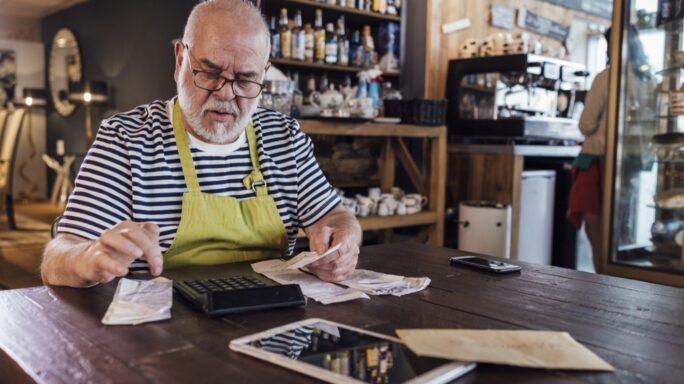Money Matters
E-commerce VAT in the EU has changed. Here’s what you need to know
The way VAT is handled for online sales from businesses worldwide to consumers in the EU changed on 1 July 2021. Learn more here.

The way VAT is handled for online sales to consumers in the European Union (that is, business to consumer) changed on 1 July 2021.
The changes remove certain provisions that Irish businesses might have been accounting for when selling to consumers in other EU countries, such as distance selling VAT thresholds. But they introduce new ways that can optionally be used to account for VAT for these sales.
These can make accounting simpler.
The changes are commonly referred to as the EU VAT E-commerce Package.
One Stop Shop (OSS) and Import One Stop Shop (IOSS) are gaining most attention because of their benefits to business.
Any business that has used the Mini One-Stop-Shop (MOSS) for certain kinds of digital services will know of the benefits of OSS and IOSS. The new measures extend MOSS by opening it up to more services and also goods including those imported into the EU, thereby potentially simplifying VAT for many more kinds of sales.
It should be noted that neither OSS nor IOSS are mandatory.
As an alternative, Irish businesses can register for and then both account for and pay VAT in each of the EU countries in which they sell to consumers. This is administratively onerous, of course, and is one of the reasons why OSS and IOSS were created.
It should also be noted that these new VAT measures are limited to online sales to consumers in the EU. If you’re selling online to a business in the EU, nothing has changed.
As with any sale to a business, you should request their VAT number and not charge VAT, once you’re sure they’re registered for VAT. If they can’t supply a valid VAT number then you should charge VAT (e.g. 21%, assuming standard rate applies).
Here’s what we cover in this article:
What are the new EU VAT e-commerce measures?
- One Stop Shop (OSS)
- Import One Stop Shop (IOSS)
- Removal of distance-selling thresholds
- Abolishing of Low-Value Consignment VAT Relief
- Online marketplaces (deemed supplier rules)
Actions to take now and final thoughts
What are the new EU VAT e-commerce measures?
There are several parts to the new VAT rules, as follows.
One Stop Shop (OSS)
This is a new online portal for businesses by which non-domestic EU VAT can be reported and paid for supplies of services and online intra-community distance sales of goods to consumers across the EU.
An intra-community distance sale is one where a VATable supply of goods is made from one EU country to a consumer in a different EU country.
In the Republic of Ireland, OSS and IOSS registration and portals are provided by Revenue Online Services (ROS), while the tax authorities in other EU countries have their own version.
Assuming your business is established in Ireland then, if you want to use OSS or IOSS, you must register with Revenue by logging into your ROS account and completing the relevant forms. Perhaps it goes without saying but you’ll need to be already registered for VAT and have a VAT number.
Notably, a business is not classed as being established in Ireland if it simply has a VAT number but it physically based elsewhere.
There are two versions of OSS: Union OSS, and non-Union OSS.
- The Union OSS can be used by businesses that are established in the EU to report VAT on intra-community distance sales and non-domestic sales of services to EU consumers. This should be used by Irish businesses.
- The non-Union OSS can be used by businesses that are established outside the EU to report VAT on sales of services to EU consumers only. Some UK businesses may use this, for example.
Administratively, the OSS works in a very similar way to the previous MOSS scheme.
The VAT rate of the destination country is charged at the point of sale, then reported and paid quarterly via an online portal. Domestic supplies within Ireland continue to be reported via the domestic VAT3 Return for Revenue.
It should be noted that the sales that can be reported through OSS are subject to destination VAT regardless of whether OSS is used.
In other words, OSS is intended to be a tax simplification.
It means businesses can report and pay VAT for all B2C sales that are subject to destination VAT to all EU countries in one fell swoop.
Notably, if you sign up to OSS, you must use it for all supplies made to EU consumers outside of Ireland. For example, you can’t use it for supplies of services made in France, but report sales of services to Germany by registering for VAT in Germany.
A €10,000 turnover threshold for ‘TBE services’ (telecommunications, broadcasting and electronic) is carried over from the older Mini One Stop Shop scheme but now also applies to intra-community distance sales but notably no other services.
Before this threshold is hit, businesses can choose to use Irish VAT rules – although if they choose not to use the threshold, they are bound by their choice for two years.
For the threshold to apply, the business must have a fixed establishment, permanent address, or usually reside in Ireland or other EU state, and be registered for VAT there.
Import One Stop Shop (IOSS)
IOSS is again optional.
It only applies to online sales that are B2C imports of goods into an EU country from outside the EU (that is, from a so-called third country or third territory). If the goods are warehoused in any EU country, even if that’s outside Ireland but still in the EU, then IOSS can’t be used.
However, for those that want to use it, IOSS offers a way of accounting for VAT to reduce confusion for customers, in that the consumer sees a single accurate cost at the point of sale. It should also help expedite movement of goods across national borders.
IOSS can be used when importing goods to Irish consumers as well as when importing goods to other EU consumers.
Administratively, the scheme is similar to the OSS in that when the seller signs up to use IOSS, they can use a single online portal to report and pay the VAT – although this is done monthly rather than quarterly.
IOSS can be used only for consignments of €150 and below, or equivalent local currency in the consumer’s country.
If the seller chooses to register for and use IOSS, then VAT of the destination country is again charged and collected by the seller at point of sale.
Businesses may question why they should bother with IOSS. The key focus should be customer satisfaction.
As mentioned, the use of IOSS means goods travel through customs faster at the destination country, because the VAT has already been calculated and accounted for, rather than having to be applied upon import.
It also means the end customer has full visibility of cost and won’t incur hidden costs further down the line when goods go through customs.
An important caveat is that IOSS covers consignments, rather than individual items.
So, if a consumer orders several items totalling more than €150 that are dispatched in the same order, IOSS does not apply. Furthermore, IOSS only covers items not subject to excise duties (e.g. it doesn’t apply to alcohol or tobacco products).
Removal of distance-selling thresholds
EU distance selling thresholds were removed as of 1 July 2021.
Previously, this meant VAT only applied to intra-community distance sales if annual turnover was more than €35,000 for sales to most EU countries, or €100,000 per annum for Germany, the Netherlands and Luxembourg.
Removal of the threshold was a mandatory change that affects any business carrying out intra-community distance sales, regardless of whether they use OSS or otherwise.
The removal of the threshold goes hand-in-hand with the introduction of OSS and is effectively a powerful incentive to make use of OSS.
It should also be noted that, for services, the place of supply rules remains unchanged.
That is, where you tax a service sale now will be where you tax it after 1 July 2021. But the expansion of MOSS to OSS will mean any B2C service sale subject to destination VAT can now be reported through OSS, not just TBE services.
Abolishing of Low-Value Consignment VAT Relief
Imports of goods less than €22 are no longer exempted from import VAT.
VAT must be charged on all goods – whether that be via import VAT at point of entry or at point of sale by the seller where the IOSS is used. However, remember, the latter is only available on B2C consignments worth €150 or less.
The removal of low-value consignment VAT relief has been implemented to level the playing field between domestic and non-domestic sellers, the latter of whom were seen to be at an unfair advantage when selling goods below €22.
However, while low-value goods imported into the EU now incur VAT, sellers can use the IOSS to help smooth the administration of the resulting VAT.
Online marketplaces (deemed supplier rules)
The new EU VAT rules mean so-called ‘electronic interface’ marketplaces and platforms, such as Amazon and eBay, are the deemed supplier for VAT purposes in certain cases when distance selling to EU consumers.
This affects sellers who use sites such as the aforementioned marketplaces and platforms. But it could also affect smaller businesses such as online antique dealers that retail items on behalf of clients.
Deemed supplier rules remove the need for sellers who use these marketplaces to account for VAT at the point of sale.
Effectively, it’s as if each consumer purchase process means they sell the goods to the online marketplace, who then sell the goods to the consumer and account for VAT while doing so.
A deemed supplier can use the OSS to report VAT in relation to intra-community supplies between EU countries, and also supplies within that same country (e.g. the goods are sent from somebody in Ireland to an Irish consumer) where the seller is not established in the EU.
In other words, use of the OSS means a deemed supplier doesn’t have to report the sale as a domestic supply for VAT purposes. They can also use IOSS to report VAT in relation to B2C imports into the EU with a consignment value below €150.
Actions to take now and final thoughts
If you decide that OSS and/or IOSS are worthwhile for your business, there’s a handful of steps that you should take right now:
- Look into registering for OSS, non-Union OSS and IOSS, depending on your needs. Most Irish businesses will do this via their existing ROS VAT account with Revenue. If your business is not established in Ireland or elsewhere in the EU, then registering for IOSS involves finding an intermediary to act on your behalf.
- You may have to reconfigure your e-commerce software so variable VAT rates can be applied depending on which EU country you’re selling into. This is already possible with popular apps such as Shopify.
- Your accounting software will need to accommodate the same kind of variable VAT rates for each country.
- If you sell through an electronic interface marketplace such as Amazon or eBay, you should consult their documentation about how the deemed seller rules will affect what you sell.
As is always the case with VAT, the new OSS/IOSS schemes are simple yet filled with myriad details that can catch out the unwary.
Ultimately, they’re to be welcomed by businesses because of the simplicity they bring to distance selling to EU consumers.
Editor’s note: This article was first published in June 2021 but has been updated for relevance.
FAQs on new EU ecommerce VAT rules
Get the answers to questions you may have about the changes to the way VAT is handled for online sales to consumers in the European Union.








What T code in Sage should be used for invoicing of Services to Great Britain (now outside EU) ?
Thanks and regards,
Arthur
Do you sign up for OSS if you don’t export ?
For the purpose of registering for IOSS in Ireland where can we find an intermediary in Ireland.
What are the typical costs?
Thanks
Joe